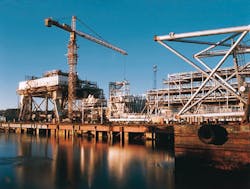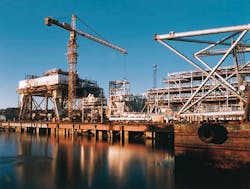FPSO hulls, turnkey services preoccupy Norwegian yards
No slowup in floating and development technology
Nick Terdre
Editor, Norway
Åsgard A piperacks and flare boom under construction at Aker Stord.Norway's offshore fabrication yards are working near capacity, but it is unclear at present how long the boom will last, especially in the light of the new government's declared intention to slow the pace of development activity.
At present, there is no lack of potential future development projects, which suggests fabrication demand should remain at a high level over the next couple of years. Floaters continue to make up the bulk of upcoming projects.
Saga shortly may award a contract for a large - around 23,000 tons - semisubmersible unit for Snorre North. This installation, Saga promises, will be crammed with environmentally sound technology.
The same operator also is in the early stages of planning the complex Halten Bank South development, including a large TLP on Kristin to which subsea completions on Lavrans, Tyrihans and Trestakk will be tied back.
Other possible floaters include dedicated oil FPSOs on Statoil's Midgard and Snoehvit fields, an FPSO on Norsk Hydro's Gjoea Field and a semisub for the same operator's Fram.
Fabrication contracts for water injection platforms for Phillips' Eldfisk and Amoco's Valhall fields may have recently been awarded.
Bids also have been submitted for Statoil's Huldra wellhead platform - the field is currently planned to start production in 2000.
Amerada Hess is expected to invite bids soon for a small wellhead platform for Mjoelner
Other projects expected to be launched in the next year or so include Statoil's Sleipner Theta West and Glitne and Hydro's Grane - each case, probably will require a process platform and a wellhead platform.
A large - 6,500 tons - gas processing/export module is under consideration for the Heidrun platform, and an additional module likely will be needed on Statoil's Troll A platform.
Awards for all these outstanding items could come through by 2000 - unless the new Norwegian coalition government decides to apply the brakes. However, the new government does not command the overall support of the Storting (parliament), where most members are believed to back the previous administration's policy of letting the industry dictate events at its own pace.
In contractor circles, the feeling is that any slowdown most likely will hit development activity in the longer term through postponement of future licensing rounds.
Other factors also are having an effect:
The gas supply committee has postponed the next allocation round by 7 months to September 1998, due to the more than ample flow of supplies from existing and planned fields. This means authorization for new developments will slip into 1999, possibly hitting projects such as Halten Bank South.
Mid-Norway potential
Despite the high level of current yard occupation, fabricators - most of which belong to groups with integrated contractor capabilities - are jockeying for position to bid on upcoming projects.A relative newcomer is Reinertsen Vigor, a yard located at Orkanger in mid-Norway, and a member of the Reinertsen group. This yard wants to play a major role in mid-Norway developments such as Halten Bank South and any others that arise from the current deepwater exploration campaigns in these waters.
Though not of a size to take on the role of main contractor for a development project, Reinertsen is aiming for turnkey responsibility for sub-projects. "Give us the functional specifications and we will come up with the most cost-effective solution," says Geir Suul, managing director of the yard. He claims that fabricators' margins currently are too small to make a purely sub-contract role worthwhile.
A combination of niche expertise and partnering is the direction Heerema Toensberg has chosen. This company has a strong track record in wellhead and water injection platforms, including on a turnkey basis. It also is willing to work as a partner alongside a main contractor, according to Marketing Manager Harald Svensen.
The big yards also are enhancing their turnkey capabilities - both Aker Maritime and Kværner have reorganized their operations along more cost-efffective, "customer-friendly" lines. They also have joined forces to bid for the Snorre North project, a move prompted primarily by lack of available engineering capacity.
Their sole rival for this contract is the Umoe group, which additionally intends to compete with the big guns on the FPSO front. Currently it is looking for a yard in Europe in which to build hulls. This is the one major item missing from Norway's system, but both Aker Maritime and Kværner own yards in Finland which can handle this task.
Presently, the Norwegian fabrication sector is so busy that in recent months a number of contracts have had to be placed abroad. For instance, the 3,000-ton drilling module for Esso Norge's Jotun project was directed to Kværner's Teesside yard in northern England, while the 4,000-ton separation module for Statoil's Åsgard B went to Italian joint venture SaiRos.
Copyright 1997 Oil & Gas Journal. All Rights Reserved.

